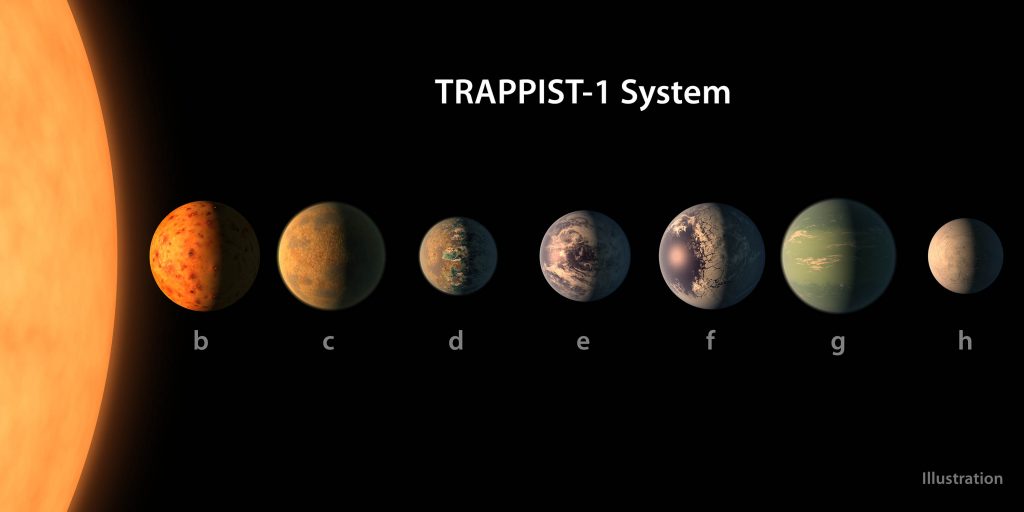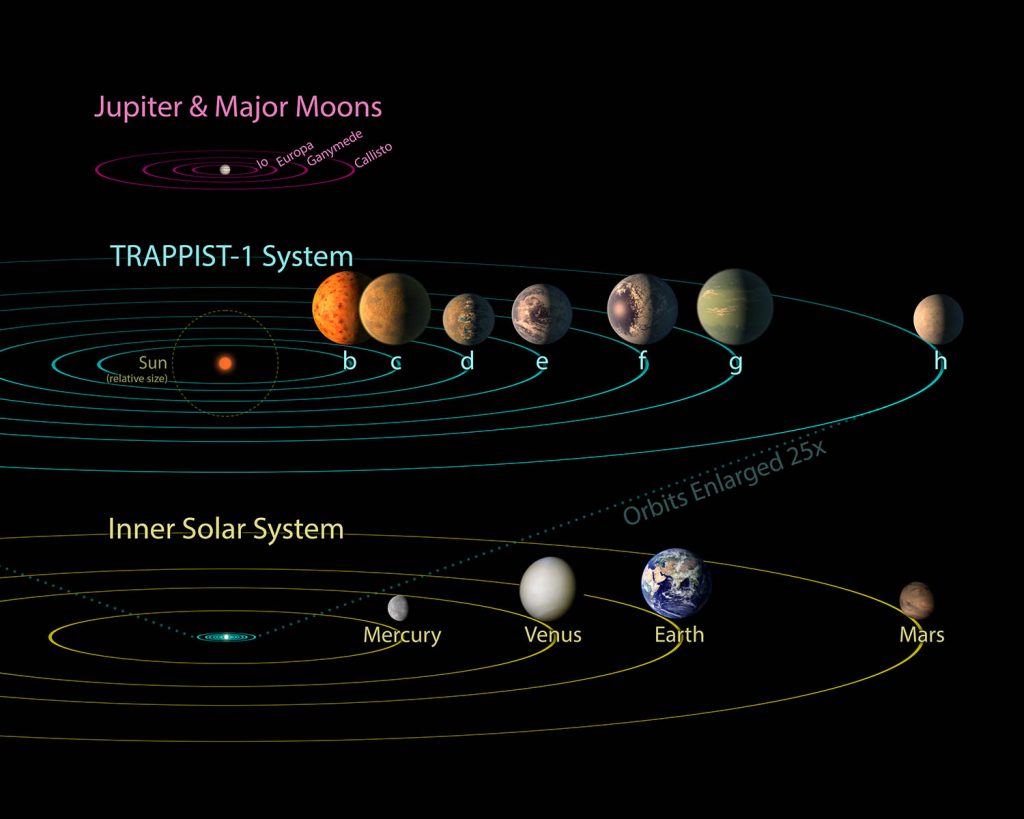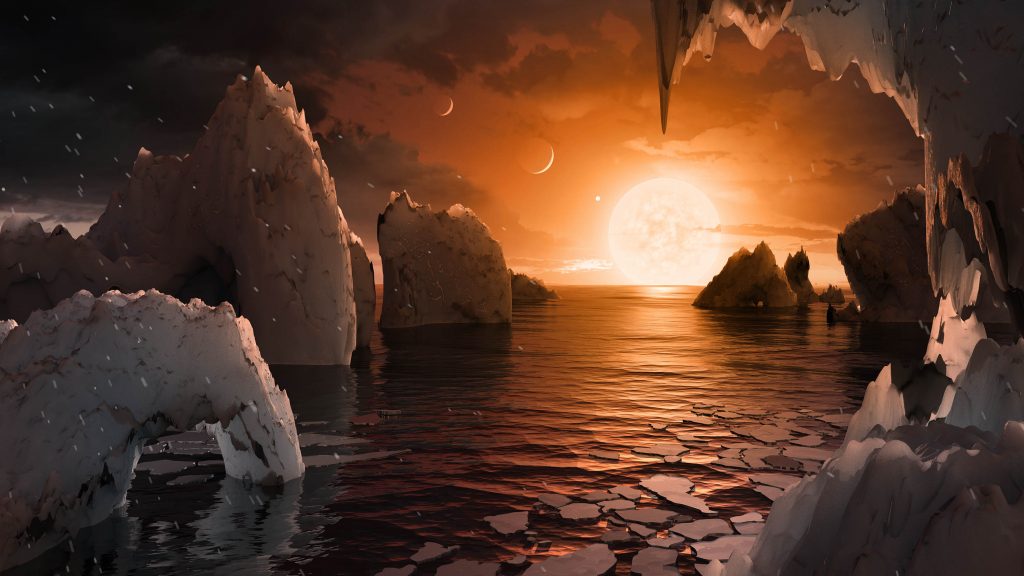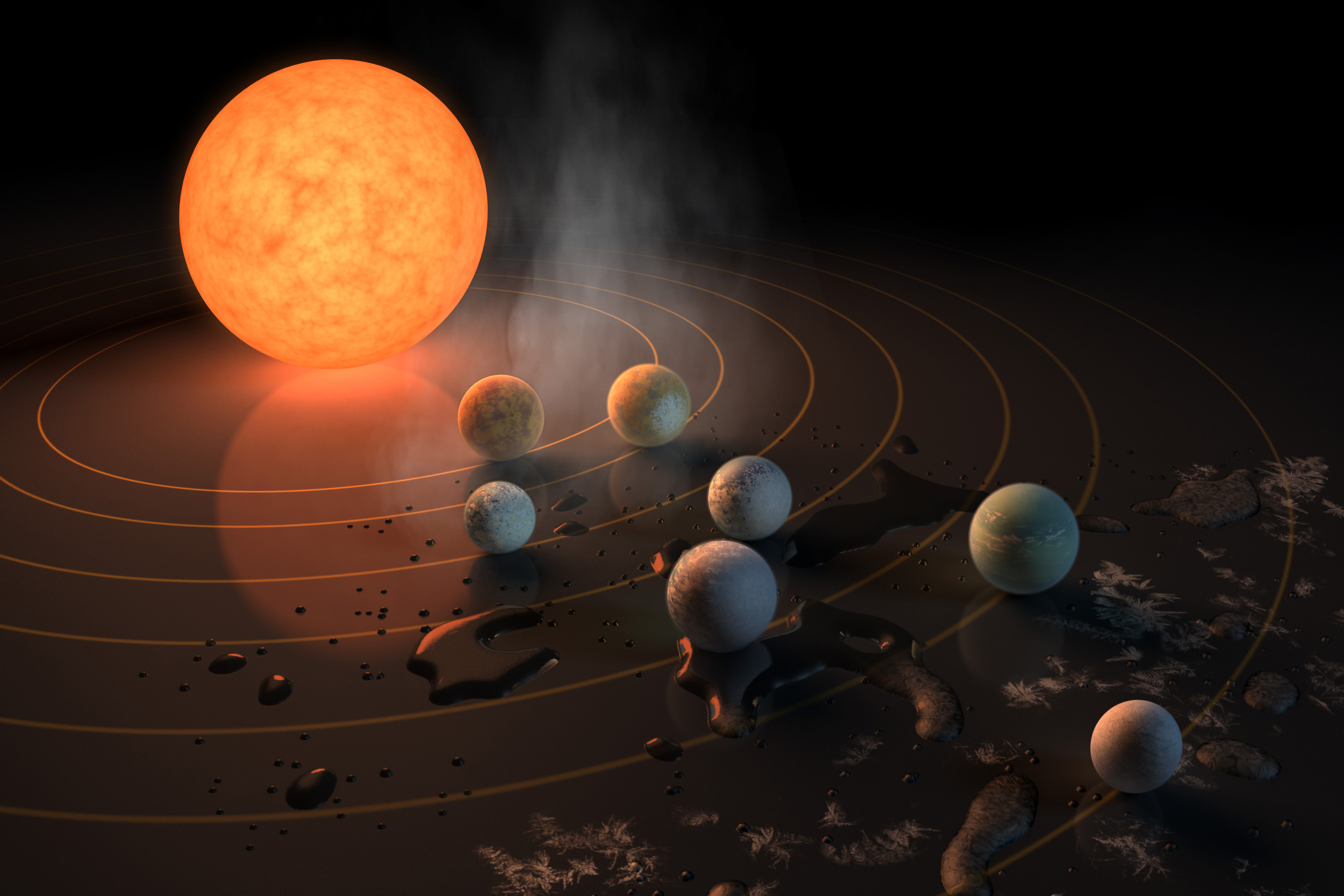NASA revealed on Feb. 22 that astronomers had discovered a nearby star with seven Earth-like planets. The discovery intrigued astronomers because the star is very small – only a little bigger than Jupiter – and three of the planets are located in the “habitable zone,” meaning they might be able to support life. UConn Today asked UConn astronomers Kate Whitaker, Cara Battersby, and Jonathan Trump to explain how the discovery was made and what it might mean.
Q. Where is this star system in relation to us, and how big is it?

Whitaker: This exciting discovery is of seven Earth-sized planets orbiting a star named TRAPPIST-1. TRAPPIST-1 is located only 12 parsecs away, or 39 light years. This is amazingly close to our own Solar System. However, because it is outside of our Solar System, we refer to it as an “exoplanet” system. This particular star is only about 8 percent the mass of the sun: a cool dwarf star of similar size to our own planet Jupiter. Astronomers already discovered in 2015 that there were three Earth-sized planets orbiting this star, but this recent discovery found an additional four.
The masses of these seven planets range from roughly half the mass of Earth to 1.4 times larger. Their radii are also quite similar to that of Planet Earth, ranging from about 25 percent smaller to 10 percent larger.
Q. How did astronomers see the planets?
Battersby: Despite some of the gorgeous visuals, astronomers haven’t actually seen the planets themselves. What we have seen is their effect on their host star, TRAPPIST-1. Astronomers monitored the brightness of the star. If there happen to be any planets orbiting that star and the system is aligned just right, we can actually see the star dim when the planet transits or passes in front of it. We can occasionally see this effect in our own system from Earth, when Venus transits or goes in front of the sun. By monitoring the brightness of the star for long amounts of time, astronomers can see multiple dimming events due to these transits and learn things about the planets’ orbits, how many planets there are, and even what size they are! Pretty cool.
For this study, astronomers used a variety of ground-based telescopes (the Very Large Telescope in Chile, UKIRT in Hawaii, TRAPPIST-south in Chile, TRAPPIST-north in Morocco, two telescopes in Spain, and the South African Observatory) to carefully monitor the brightness of TRAPPIST-1. In fact, this exoplanet system gets its name TRAPPIST-1 from the Transiting Planets and Planetesimals Small Telescope (TRAPPIST) in Chile. Early on, there was evidence of at least one planetary transit, so the astronomers kept watching the star. Each new observation allowed astronomers to constrain the properties of the system (number of planets, orbital period, size), but there was still some overlap and uncertainty.
The culmination of this amazing campaign was during the 20-day continuous monitoring project undertaken by the Spitzer Space Telescope, starting on Sept. 19, 2016. This final monitoring project allowed astronomers to observe not just intermediary transits of the planets, but allowed them to see all of the transits continuously, multiple times, finally determining the number of planets in the system, their sizes, and orbital periods. And the results were extraordinary!
Q. Why was this discovery so surprising?
Battersby: The surprising thing about this discovery was to have so many Earth-like planets around one star and in the habitable zone. This system is much different than our solar system. An image from the NASA website highlights this really well:

The planets are really close together, really close to their star, and there are so many rocky – or Earth-like – planets in the habitable zone! We are still learning so much about how planetary systems form. This example, which is so different than our own, and different than many other exoplanetary systems we’ve seen, opens our eyes to what is possible. As scientists, we want to understand how these systems form, and most of our current models focus on reproducing different types of systems (like our own, or other exoplanet systems). How did this one form?
Most of all, some of us might have dreamed that such a planetary system was possible, but NASA just made that dream a reality, and it surprised a lot of folks because of how different it is from what we’ve seen before. The better our telescopes get, the more we can search out new, different types of planetary systems, like the one we’ve seen here at TRAPPIST-1. How many other weird systems are out there, waiting to be discovered? Or are we the weird ones after all?
Trump: For me, the most surprising part of the discovery is the host star: it is remarkably small, with a mass just barely large enough to be a star with fusion in its core. It’s not obvious that such tiny stars should have planets at all – instead, most planet searches have been around stars more like our Sun.
Observing the sky from one of these planets, the nearest two other planets would be slightly larger than the Moon – so quite a view!
Q. How can there possibly be seven planets in the habitable zone of a small star? Don’t we only have space for one – Earth?
Whitaker: Remember that there is a vast amount of space between each of the planets in our own Solar System, so it isn’t impossible to conceive of such a large number of planets orbiting so close together.
From measuring their orbital periods, the team of astronomers believe that the planets likely formed further away from the star and migrated inwards until they reached their current near-resonant locations. Such an orbital resonance occurs when a planet and star exert a regular, periodic gravitational influence on each other because their orbital periods are related by ratios of small integers. According to the measured periods, this appears to be the case for an impressive six out of the seven planets discovered at TRAPPIST-1.
Trump: Note that the “habitable zone” really just refers to temperature. By some definitions, both Venus and Mars are in our solar system’s habitable zone: but Venus has way too much atmosphere and a runaway greenhouse effect, and Mars has way too little atmosphere. We don’t yet know anything about the atmospheres of the TRAPPIST-1 planets. I suspect that Hubble observations will soon be used to learn more.

The Trappist-1 system also has some unusual traits that make life a bit more challenging. All seven planets are very likely to be tidally locked to their star: that means one side will be in permanent daylight, while the other is in permanent night. (Our Moon is tidally locked to Earth in the same fashion, such that we always see the same side of the Moon.) Tidal locking would make for some pretty extreme weather as the atmosphere moves across the day/night divide. In addition, this star is unusually X-ray bright (for its low mass): its planets receive ~1000 times as much X-ray light as Earth, and this harsh radiation would be likely to destroy molecules (like O2, CO2, and H2O) in an atmosphere.
I certainly don’t mean to be discouraging – even if life is more challenging on these planets than on Earth, it’s an incredible discovery to find a solar system around such a tiny star. As I see it, the history of planet-hunting has been that almost everywhere we are able to look, we find planets! That’s enough to suggest that we’re very unlikely to be alone in the Universe.



